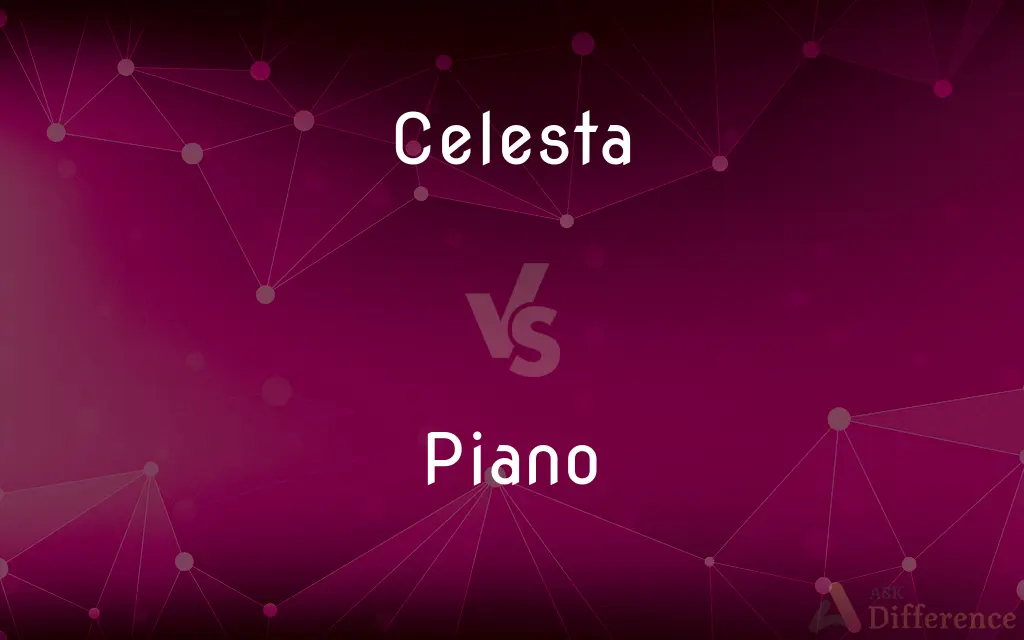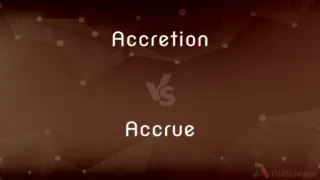Celesta vs. Piano — What's the Difference?
By Tayyaba Rehman & Maham Liaqat — Updated on April 27, 2024
Celesta produces a delicate, bell-like sound using metal plates struck by hammers, whereas a piano offers a wide range of dynamic tones through felt-covered hammers hitting strings

Difference Between Celesta and Piano
Table of Contents
ADVERTISEMENT
Key Differences
The celesta uses metal plates to create its unique sound, resonating with a fairy-like, twinkling quality that is often used to enhance atmospheric and ethereal passages in music. On the other hand, the piano employs tightly strung wires that are struck by hammers, allowing for a robust and dynamic range of sounds that can convey a broad spectrum of emotions and musical styles.
Celestas typically feature a keyboard with a range similar to that of a small piano, but due to the nature of its construction, it has a much softer and more muted presence. In contrast, pianos are available in various sizes from small uprights to large grand pianos, which can fill concert halls with powerful acoustics.
While the playing technique for the celesta is similar to that of the piano, involving a keyboard layout where keys are pressed to create sound, the touch and response are much lighter on the celesta. Conversely, piano players often emphasize dynamics and expression, which requires a responsive touch and considerable finger strength.In terms of use in compositions.
The celesta is frequently utilized to add a magical or whimsical touch to pieces, famously featured in Tchaikovsky's "Dance of the Sugar Plum Fairy." Whereas, the piano is a staple in a wide variety of musical genres, from classical sonatas to jazz improvisation, serving both as a solo and an ensemble instrument.
Celestas are less common in everyday settings and are typically found in orchestras and specialized musical environments. Meanwhile, pianos are ubiquitous in the musical world, found in homes, schools, and on professional stages, making them more accessible and familiar to the general public.
ADVERTISEMENT
Comparison Chart
Sound Production
Metal plates struck by hammers
Strings struck by felt-covered hammers
Sound Character
Bell-like, ethereal
Broad dynamic range, expressive
Typical Use
Orchestral, atmospheric pieces
Versatile, all genres
Size and Portability
Smaller, more portable
Ranges from small to very large
Playing Technique
Light touch required
Dynamic touch, varying finger strength
Compare with Definitions
Celesta
Often compared to a glockenspiel due to its similar timbre but played on a keyboard.
Unlike the glockenspiel, the celesta's keyboard allows for faster and more fluid playing.
Piano
Can vary greatly in size from small upright models to large grand pianos.
They bought an upright piano to save space in their small apartment.
Celesta
Less common in popular music, primarily found in classical compositions.
The composer chose a celesta to achieve the gentle twinkling effect in his new symphony.
Piano
Essential for teaching and practicing music, common in schools and homes.
Children learning on the piano gain a solid foundation in music theory and technique.
Celesta
Known for its magical sound, often used in orchestral music to evoke a fairy-tale atmosphere.
She played the celesta part beautifully, enhancing the mystical vibe of the piece.
Piano
Known for its dynamic range and ability to produce soft and loud sounds.
She expertly used the piano's dynamic range to express the song's emotional depth.
Celesta
A small keyboard instrument using struck metal plates to produce a delicate, bell-like sound.
The celesta added a dreamy quality to the orchestra's performance.
Piano
The piano is an acoustic, stringed musical instrument invented in Italy by Bartolomeo Cristofori around the year 1700 (the exact year is uncertain), in which the strings are struck by wooden hammers that are coated with a softer material (modern hammers are covered with dense wool felt; some early pianos used leather). It is played using a keyboard, which is a row of keys (small levers) that the performer presses down or strikes with the fingers and thumbs of both hands to cause the hammers to strike the strings.
Celesta
The celesta or celeste , also called a bell-piano, is a struck idiophone operated by a keyboard. It looks similar to an upright piano (four- or five-octave), albeit with smaller keys and a much smaller cabinet, or a large wooden music box (three-octave).
Piano
A large keyboard musical instrument with a wooden case enclosing a soundboard and metal strings, which are struck by hammers when the keys are depressed. The strings' vibration is stopped by dampers when the keys are released and can be regulated for length and volume by two or three pedals.
Celesta
Typically has a compass of about four to five octaves, similar to some pianos.
The celesta’s range allowed the musician to perform a wide variety of melodies.
Piano
A passage performed or marked to be performed softly.
Celesta
A musical instrument with a keyboard and metal plates struck by hammers that produce bell-like tones.
Piano
(especially as a direction) soft or softly.
Celesta
(musical instruments) A musical instrument consisting principally of a set of graduated steel plates struck with hammers that are activated by a keyboard.
Piano
(especially as a direction) soft or softly.
Celesta
A musical instrument consisting of graduated steel plates that are struck by hammers activated by a keyboard.
Piano
A musical instrument with a manual keyboard actuating hammers that strike wire strings, producing sounds that may be softened or sustained by means of pedals.
Celesta
A musical instrument consisting of graduated steel plates that are struck by hammers activated by a keyboard
Piano
A passage to be played softly or quietly.
Piano
In a soft or quiet tone. Used chiefly as a direction.
Piano
(musical instruments) a percussive keyboard musical instrument, usually ranging over seven octaves, with white and black colored keys, played by pressing these keys, causing hammers to strike strings
The piano in his house takes up a lot of space.
She has been taking lessons for many years and now plays piano very well.
Piano
To play the piano.
Piano
(of or with fingers) To move (the fingers) up and down on, similar to the motions of a pianist playing the piano.
Piano
To equip with a piano.
Piano
To become softer and less intense.
Piano
(music) softly, as a musical direction (abbreviated to p. in sheet music)
Piano
(music) Soft, quiet.
Piano
(in extended use) Gentle, soft, subdued.
Piano
Soft; - a direction to the performer to execute a certain passage softly, and with diminished volume of tone. (Abbrev. p.
Piano
A well-known musical instrument somewhat resembling the harpsichord, and consisting of a series of wires of graduated length, thickness, and tension, struck by hammers moved by keys.
Piano
A stringed instrument that is played by depressing keys that cause hammers to strike tuned strings and produce sounds
Piano
(music) low loudness
Piano
Used chiefly as a direction or description in music;
The piano passages in the composition
Piano
Used as a direction in music; to be played relatively softly
Piano
A large musical instrument with a keyboard that strikes strings with hammers to produce sound.
The grand piano dominated the stage with its imposing presence and rich sound.
Piano
Widely used in both solo and ensemble settings across numerous musical genres.
His jazz piano skills were exceptional, captivating the audience with every note.
Common Curiosities
Can you describe the playing technique for the celesta?
The celesta requires a light touch with minimal finger pressure.
How does the piano's sound production differ from the celesta's?
The piano uses felt-covered hammers to strike strings, allowing for a wide range of dynamics.
What is the typical use of a piano in musical compositions?
The piano is used extensively across solo, chamber, and orchestral music.
What makes the piano suitable for various musical genres?
Its ability to produce diverse dynamics makes the piano versatile for all musical genres.
Is the celesta as common as the piano in music education?
No, the celesta is less common than the piano, which is a staple in music education.
What type of sound does a celesta produce?
The celesta produces a delicate, bell-like sound.
Where is the celesta typically used?
The celesta is typically used in orchestral settings to add atmospheric effects.
What are the common sizes of pianos available?
Pianos range from small uprights to large grand pianos.
How does the portability of a celesta compare to a piano?
The celesta is generally more portable than most pianos.
What kind of music benefits from the unique sound of the celesta?
Music that seeks to create an ethereal or magical atmosphere often benefits from the celesta.
How does the touch of a celesta compare to that of a piano?
The celesta’s touch is lighter compared to the dynamic touch required for piano.
Share Your Discovery

Previous Comparison
Accretion vs. Accrue
Next Comparison
Camel vs. ShipAuthor Spotlight
Written by
Tayyaba RehmanTayyaba Rehman is a distinguished writer, currently serving as a primary contributor to askdifference.com. As a researcher in semantics and etymology, Tayyaba's passion for the complexity of languages and their distinctions has found a perfect home on the platform. Tayyaba delves into the intricacies of language, distinguishing between commonly confused words and phrases, thereby providing clarity for readers worldwide.
Co-written by
Maham Liaqat













































